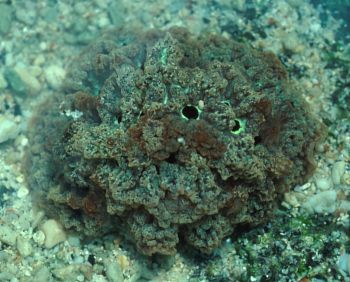
Atagema spongiosa
(Kelaart, 1858)
Order: NUDIBRANCHIA
Suborder: DORIDINA
Superfamily: EUDORIDOIDEA
Family: Dorididae
DISTRIBUTION
Indo-West Pacific
PHOTO
AM C137597, 60 mm long alive. 24 November 1982, Public swimming pool, Christmas Is., Indian Ocean. Photo: John Hicks
Formerly known as Trippa spongiosa. See message
This species is one of a number of dorids with a very sponge-like appearance. One very distinctive feature is the dark purplish underside of its mantle, with a milky green margin. Doris areolata Alder & Hancock, 1864 and Phlegmodoris paagoumenei Risbec, 1928 are two synonyms. It has a wide Indo-West Pacific distribution. Kelaart described it as a large, `semi-gelatinous' species with a deeply pitted mantle. The dorsum [or mantle] is a greenish-brown colour and their are often bluish-green mucous secretions exuding from the skin. The bottom of the deep pits all over the dorsum are sometimes blue-green with black margins and sometimes black with a blue-green marginal ring as in the accompanying photo. grows to at least 12cm long.
Reference:
• Kelaart, E.F. (1858). Description of new and little known species of Ceylon nudibranchiate molluscs and zoophytes. Journal of the Ceylon Branch of the Royal Asiatic Society,
Columbo, 3(1): 84-139.
Rudman, W.B., 2002 (May 15) Atagema spongiosa (Kelaart, 1858). [In] Sea Slug Forum. Australian Museum, Sydney. Available from http://www.seaslugforum.net/factsheet/tripspon
Related messages
-
Atagema spongiosa from Lord Howe Island
From: Margaret Crook, February 15, 2008 -
Atagema spongiosa? from Anilao, Philippines
From: Reindert Grooters and Mieke Snoek, August 7, 2006 -
Big purple-footed nudibranch from Singapore
From: Ron Yeo, June 28, 2006 -
Atagema spongiosa? from the Philippines
From: Erwin Koehler, December 21, 2002 -
Trippa spongiosa from Sydney
From: Ian Simpson, November 5, 2002 -
Trippa spongiosa from Sth Korea
From: Dong Bum, Koh, August 11, 2002 -
Trippa spongiosa from Christmas Island
From: W.B. Rudman, May 18, 2002
